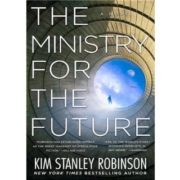Ministry For The Future
In Kim Stanley Robinson’s anti-dystopian novel, climate change is the crisis that finally forces mankind to deal with global inequality.
New York Review, by Bill McKibben
The prolific science-fiction writer Kim Stanley Robinson, who is at heart an optimist, opens his newest novel, The Ministry for the Future, with a long set piece as bleak as it is plausible. Somewhere in a small city on the Gangetic Plain in Uttar Pradesh during the summer of 2025, Frank, a young American working for an NGO, wakes up in his room above a clinic to find that an unusually severe pre-monsoon heat wave has grown hotter still and more humid—that the conditions outside are rapidly approaching the limit of human survival. Actually, conditions inside are approaching the same level, because the power has gone out.

 Graham Hardy
Graham Hardy
